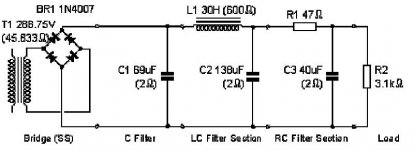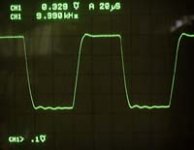Hi,
That would be fine.
If you want you can run the PS through PSU designer to verify if there's any ringing:
PSU DESIGNER
Cheers,
the first set would be electrolytics, a mixture of 22uf and 47uf. a 30H 150ma choke, next, double of the first stage. a 47ohm dropping resistor before 40uf of mkp. is this better?
That would be fine.
If you want you can run the PS through PSU designer to verify if there's any ringing:
PSU DESIGNER
Cheers,
Hi,
This is a pic taken from the output of a PP 2A3.
What you see is a slight ringing, i.e. the square wave isn't exactly square at the corners.
A similar pic can be made at the output of a choke PS since the combination of inductance and capacitance can cause a tank resonance.
Cheers,
How the ringing looks like at the graph??
This is a pic taken from the output of a PP 2A3.
What you see is a slight ringing, i.e. the square wave isn't exactly square at the corners.
A similar pic can be made at the output of a choke PS since the combination of inductance and capacitance can cause a tank resonance.
Cheers,
Attachments
Hi,
I don't know what exactly it looks like in PSUD, I haven't used it yet.
It should be pretty obvious though and i assume the software will issue a warning when you punch in vlaues that are likely to excite resonant behaviour.
Resonance is a term used to describe the property whereby a network presents a maximum or minimum impedance at a particular frequency, for example, an open circuit or a short circuit.
Resonance is important in filter theory. One simple form of resonator are lumped element RLC circuits, sometime called "tank circuits".
Why the term "tank?"
Because an LC resonator can store energy in the form of an AC sinewave, much like a pendulum "stores" gravitational energy.
The resonance of a RLC circuit occurs when the inductive and capacitive reactances are equal in magnitude but cancel each other because they are 180 degrees apart in phase.
Here's some technical overview:
INDUCTORS, CAPS AND BILLY CRYSTALS........
Cheers,
It’s something like waves up and down , at the front of the graph , until the voltage become for example 300V??
I don't know what exactly it looks like in PSUD, I haven't used it yet.
It should be pretty obvious though and i assume the software will issue a warning when you punch in vlaues that are likely to excite resonant behaviour.
Resonance is a term used to describe the property whereby a network presents a maximum or minimum impedance at a particular frequency, for example, an open circuit or a short circuit.
Resonance is important in filter theory. One simple form of resonator are lumped element RLC circuits, sometime called "tank circuits".
Why the term "tank?"
Because an LC resonator can store energy in the form of an AC sinewave, much like a pendulum "stores" gravitational energy.
The resonance of a RLC circuit occurs when the inductive and capacitive reactances are equal in magnitude but cancel each other because they are 180 degrees apart in phase.
Here's some technical overview:
INDUCTORS, CAPS AND BILLY CRYSTALS........
Cheers,
Unfortunately, it doesn't.It should be pretty obvious though and i assume the software will issue a warning when you punch in vlaues that are likely to excite resonant behaviour.
There are two methods I know of that spot ringing.
The first it to watch the power supply power up.
The telltale in this is the current in the first choke. if it has a peak and smoothly declines to its operating current, its good. the voltage on the caps should also be smooth.
The other is to use the step function. after 5 seconds, increase the current 20% and watch if the voltage undershoots and rings or if it smoothly approaches its new values of voltage and current.
I know that one of the pre-amps posted initially had a power supply that rang like a bell.
Cheers;
Doug
The PDF-file is rendered as a blank page.
Thanks Frank.
I checked the graphs.
I'll try to convert them to GIF.
Doug
- Status
- This old topic is closed. If you want to reopen this topic, contact a moderator using the "Report Post" button.
- Home
- Amplifiers
- Tubes / Valves
- MKP in the Powersupply.


